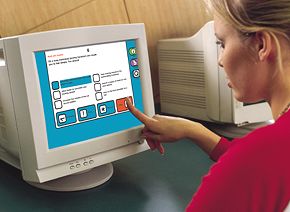The following will provide tips and advice on how to pass the car theory test and is developed by qualified individuals who have experience in teaching such matters.
For some, the theory test is straight forward and relatively easy to pass. For others, no matter how many times they attempt it and as close as it gets, they just can’t get that all important pass.
Firstly, for those that are new to the car theory test, let’s explain a little about what it is and what you should expect.
As experienced and qualified driving instructors, we shall then pass on some useful tips and knowledge that should help you pass.
The car theory test is divided into 2 sections; the theory part and the hazard perception part. You will need to pass both part of the test to pass the theory test.
 Car theory test explained
Car theory test explained
The theory section of the test is made up of multiple-choice questions. You will sit down in front of a computer monitor. The computer monitor may be touch screen and you will have the option of using a computer mouse to click your answers.
Before the test starts, you will be given on-screen instructions of how it works and what to expect. After the instructions, you will be given the option to take a practice session. You can choose to skip this if you wish. After the practice session or if you skipped it, the real test will begin.
Multiple choice car theory test
You will be given a question on the computer monitor with several possible answers. Use the mouse or if applicable, touch the screen to select your chosen answer. Some questions may need more than one answer. It will make you aware that it requires more than one answer on-screen.
You are able to flag questions that you are not sure about to come back later, you are also able to move between questions if you wish to do so. Some of the car questions will be based on a case study. An example of a case study will be to:
- show a short story that 5 questions will be based on
- focus on real life examples and experiences that you could come across when driving
For the car theory test, the pass mark is 43 out of a possible 50 questions. You are entitled to 57 minutes to complete the test. Once completed you are offered a 3 minute break. Again, you can skip this and continue to the hazard perception part of the test.
Hazard Perception test
Before the hazard perception part of the test starts, you will be shown a demonstration video clip of how it works and what to expect.
After the demonstration, the test will begin. A series of 14 video clips will be shown to you on the computer screen. The video clips will feature scenes that take place on a daily basis.
Each scene will last around 1 minute and will contain at least one developing hazard. One of the clips however, will feature two developing hazards. A situation that may require you to change speed or direction is a developing hazard.
Hazard Perception scoring
The earlier you spot a developing hazard and click the mouse button, the higher the score you will receive. The highest score possible for each developing hazard is five points.
The system is designed to detect cheating, so constant mouse clicking will result in a message appearing after the clip announcing that you have scored zero for that particular clip.
Out of a possible 75, 44 points must be scored in order to pass the hazard perception part of the theory test.
Below is an example of a typical scenario that you are likely to see in everyday driving and on the hazard perception test.
 |
Potential hazardAt this point, the lady only represents a potential hazard. As she is not a developing hazard, clicking at this time will gain zero points. |
 |
Developing hazardNow as the lady changes direction towards the road, she becomes a developing hazard. At the time she changes direction towards the road would be where the highest points of 5 will be gained. The longer it takes you to realise the developing hazard and the further into the road she walks, the less points will be gained from 5 points down to 1. |
 |
Actual hazardThe lady is now in the direct path of your car and has become an actual hazard. At this point if the mouse has been clicked, you have failed to spot the developing hazard and zero points will be gained. |


